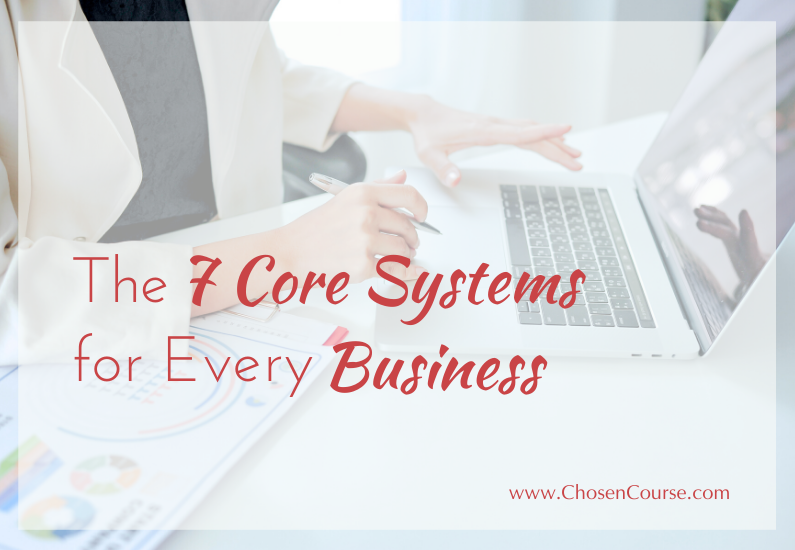It’s all about the systems, right? That’s what we’re told by just about everyone who’s successful in business. You’ve got to build solid systems. Great, but what the heck does that really mean?
To help you understand this better I wanted to dive in today to explore two questions:
1. What is a system?
2. What systems do I need for my business?
The topic of business systems has been written about many times by others, but it’s confusing. I’m not at all surprised if you feel a bit baffled about building better systems in your business. So, let’s start with some definitions because there are three words that often get used interchangeably and create a bunch of confusion: tool, system, & process.
Definitions: Tool, System, & Process
What is a Tool?
A specific app, software, hardware, gadget, or physical “office supply” that is designed (or can be used) to accomplish a particular outcome.
Examples: Asana, Canva, your smartphone, SIM Card, laptop, a lapel microphone, your paper planner, post-it notes.
Often we assume that if we just found the right app, software, or gadget that everything would be easy, but the tools are only one piece of the system puzzle. I’ve written in the past about this common misunderstanding that the right tool will magically fix whatever is broken in your business.
Now, don’t get me wrong. I love a good productivity tool, but alone they are not enough. So, if you’ve been asking around for the “best productivity app,” then keep reading because you’ll need more than that app to create the success you want.
What is a System?
The consistent use of three components (Tools, Habits, & Mindset) to organize a specific set of information.
Example: Your calendar organizes your appointments.
To function effectively this system needs:
- A digital or paper calendar tool
- Your habit of writing appointments down and reviewing it each day to ensure you show up.
- Your mindset, beliefs, personal policies about when you are and are not available, what meetings you will take and which you won’t, what your priorities are for a given day or season.
Remember, if you choose an awesome calendar tool but never put your appointments into it, then it won’t be able to ensure you show up for appointments. Your habit of using the tool is essential.
Similarly, if you say yes to every request that shows up, then you’re likely to end up feeling exhausted, over-worked, and scattered… or waking up at all hours for those meetings with people on the other side of the planet.
In this case, your tool might be tracking your appointments, but it’s not keeping your mind and business organized and focused for growth as well as it could if your mindset about how you use it were fully-aligned with your priorities. (Put on your own oxygen mask before helping anyone else *wink*)
What is a Process?
The sequence of tasks and systems used to create a consistent, repeatable outcome. A process may leverage multiple systems and specific tasks to achieve its outcome.
Example: Onboarding a new client may involve multiple systems used in a specific sequence to move someone from “Sale to Client.”
- Take notes on client’s goals and needs (Digital Note-taking System)
- Create and sign client contract (Document Org System)
- Communicate with others (client and team) about new client project (Communication System)
- Send client invoice for first payment (Financial System)
- Schedule first working meeting (Calendar & Scheduling System)
- Map out initial project vision, scope, and plan (Planning System)
- Create new client “project & tasks” to track progress (Project Management System)
Why are these distinctions important to your business?
Understanding the difference between a tool, a system, and a process will help you begin to diagnose where the gaps are in your current business’ flow, and where you really need to focus to begin to fix what’s not working or improve upon what is working.
After all, if you don’t have good habits of writing appointments in your calendar, then a new calendar tool may not be the solution to fix it, but working on a better habit development strategy may be. That’s why I include several lessons on habit development in my upcoming course The Freedom Evolution.
Similarly, if you’re great at sales and converting prospects into clients, but then struggle with the follow-through to onboard them, then that might point out that your onboarding process could use some refinement, clarification, or support from appropriate team members. Don’t have team members yet? Then, keep reading …
It’s all about solving the right problem, and yes, systems are a part of that equation for sure. But, they are not the whole story.
The 7 CORE Business Systems
- Cloud Document Organization System (Documents & Files)
- Digital Notebook System (Note-taking)
- Calendar & Scheduling System (Appointments)
- Project Management System (Projects/Tasks/Priorities)
- Team Communications Systems (Email/Communications/Messages)
- Financial & Bookkeeping Systems (Finances)
- Personal Productivity & Planning Systems (Vision/Plan/Goals/Balance)
Do You Have the Recipe for Your Secret Sauce?
- Brainstorm the processes that you can simplify, document, and delegate to start freeing your time and energy.
- Get a step-by-step approach to develop your business processes so they become easier to do and to delegate.
- Identify the areas of your business where you’ve been “flying-by-the-seat-of-your-pants” for too long and wasting time and energy.
- Walk you through a checklist of 50+ Business Processes to clarify what’s working (or not) in your current business.



